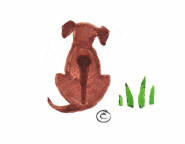


|
Origins When the first Dutch settlers landed at Table Bay in 1652, they found the Cape was
inhabited by the Hottentots, who hunted with dogs of a peculiar appearance: medium- Development Towards the late 1800's, a majority of British settlers colonised land north of the
Limpopo river, defeated the local tribes and created Rhodesia. Early Rhodesia was
"lion country" and a type of "Lionhound" was needed desperately. The ancestry of
the early Ridgeback made him perfect for that title and purpose: he possessed a good
nose, speed, stamina, courage, dash & spirit, hunting skills, immunity against disease
and his identity - Standardisation Mr Francis Richard Barnes acquired his first ridged dog in 1915 while in Bulawayo. "Dingo" was descended from one of Cornelius van Rooyen's hunting dogs, who was impressed with 2 hounds owned by Rev Charles Helm and bred from them. When the Barnes' moved and began farming at Figtree, the famous Eskdale Ridgebacks began and Eskdale Jock, Leo & Connie were foundations of the breed; they soon produced hounds that were practical and beautiful. It became obvious that a breed standard was needed; in 1922 Mr Barnes called a meeting of ridged dog owners at the venue of the Bulawayo KC Show. From those present at the meeting, great variety in colour, coat and size were found, but following much discussion, Mr Barnes drew up a Standard from those qualities most desired. It resulted in a Standard of conformation similar to the Dalmatian (only bigger), and remains unchanged to date apart from the brindle colour now being unacceptable and white allowed only on chest & feet. Modern dogs are somewhat heavier than their ancestors. The Parent Club was formed and 2 years later, the Rhodesian Ridgeback "Lion Dog" was recognised by the SA Kennel Union. The first dogs were registered in September 1925, the first Champion was made up 3 years later. They were excellent hunters & reliable protectors of homesteads, soon becoming popular as companions to those in towns & cities. As the finest examples of the breed were exported, the Rhodesian Ridgeback gained fame across the world. |